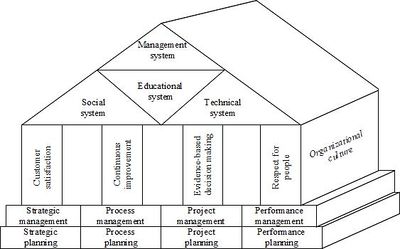House of total quality model
House of Total Quality Model has been developed by F. Voehl in 1992 and modified by W.M. Lindsay and J.A. Petrick in 1997. It consists of six groups of elements (T.P. Mani, N. Murugan, C. Rajendran, 2003, p. 610):
- Subsystems of the organization, such as management system, education, social and technical subsystems (roof).
- Continuous improvement of customer satisfaction, basing decisions on facts and respect for people (pillars of quality).
- Strategic management, processes, projects and tasks (base).
- Strategic planning of processes, projects and tasks (benches).
- Development of organization (mortar).
- Corporate culture (the wall).
The base of the model are the basic tasks performed in the organization. On them, four-element approach to the quality is constructed and implemented. Stable operation is provided by the appropriate management of organization which binds together the pillars. Organizational culture makes all these activities not just a façade. Thanks to it, they not only exist inside the company but also bring considerable benefits.
House of Total Quality model shows the overall approach to quality management system. Its implementation requires the operationalization of key organizational processes and introducing several different management methods and techniques. It can be a starting point for further development of detailed models for specific industries or sectors of the economy.
See also
Advantages of House of total quality model
The House of Total Quality Model developed by F. Voehl in 1992 and modified by W.M. Lindsay and J.A. Petrick in 1997 is a comprehensive system that allows organizations to improve the quality of their products and services. The model consists of six groups of elements and has several advantages, such as:
- It provides a comprehensive approach to quality improvement, as it takes into account all aspects of the organization and the product/service.
- It helps identify potential areas for improvement, allowing organizations to identify areas where they can improve quality and increase efficiency.
- It encourages an organizational culture that focuses on continual improvement and customer satisfaction.
- It helps organizations to improve customer relationships and loyalty by providing a framework for measuring customer satisfaction.
- It helps to reduce costs and increase profits by identifying inefficiencies and opportunities for cost savings.
- It allows organizations to develop metrics and systems to track and improve quality over time.
Limitations of House of total quality model
The House of Total Quality Model has six groups of elements which are essential for quality management. However, there are some limitations to this model which need to be considered for proper implementation. These include:
- Lack of integration of customer feedback into the model - customer feedback is essential to measure the quality of the product and should be included as part of the model.
- Lack of guidance on how to integrate each element into the overall quality system - each element of the model needs to be integrated into the overall quality system in order to ensure the most effective results.
- Limited guidance on how to manage the relationship between the six elements - the model does not provide sufficient guidance on how to manage the relationship between the six elements in order to ensure the best results.
- Limited guidance on how to effectively measure and monitor quality performance - the model does not provide sufficient guidance on how to measure and monitor quality performance to ensure it remains high.
- Lack of a unified approach to quality management - the model does not provide a unified approach to quality management, which can lead to confusion and inconsistency in implementation.
- Lack of guidance on how to deal with non-conformities - the model does not provide sufficient guidance on how to identify, investigate and address non-conformities.
- The House of Total Quality Model has spawned several other approaches related to its core concepts. These include:
- Total Quality Management (TQM), which focuses on the quality of a product or service from the perspective of the customer. It emphasizes continuous improvement, defect prevention and customer satisfaction.
- Lean Manufacturing, which is an operational strategy based on the principles of minimizing waste and maximizing efficiency. It emphasizes the elimination of activities that don’t add value to the customer.
- Six Sigma, which is a set of principles and tools used to identify and eliminate defects in processes. It focuses on reducing variation in a process and is used to improve customer satisfaction and reduce costs.
- AGILE, which is a methodology used to manage projects in a collaborative and flexible way. It emphasizes rapid delivery of high-quality products to customers.
- Kaizen, which is a Japanese term for continuous improvement. It emphasizes small, incremental improvements in the quality of products and processes.
In summary, the House of Total Quality Model has spawned several other approaches, such as Total Quality Management, Lean Manufacturing, Six Sigma, AGILE, and Kaizen, which focus on different aspects of quality and customer satisfaction.
| House of total quality model — recommended articles |
| Value management — Silvestro model — Armand Feigenbaum — Philip B. Crosby — World class manufacturing — Total quality control — Joseph M. Juran — Operational effectiveness — Lean manufacturing |
References
- Voehl F., (1992) The house of total quality, Coral Springs, Fl: Strategy Associates, 1992
- Lindsay, W.M.; Petrick, J.A. (1997) Total Quality and Organization Development, St. Lucie Press
- Mani T. P., Murugan N., Rajendran C., (2003) Classical approach to contemporary TQM: an integrated conceptual TQM model as perceived in Tamil classical literature, Total Quality Management, 5
Author: Slawomir Wawak
